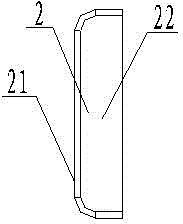Wall-mounted air conditioner
A technology for wall-mounted air conditioners and air conditioners, applied in heating and ventilation hoods/covers, etc., can solve the problems of dust entry, easy deformation, etc., and achieve the effect of enhancing the ability to resist bending stress, the overall structure and aesthetic breakthrough.
- Summary
- Abstract
- Description
- Claims
- Application Information
AI Technical Summary
Problems solved by technology
Method used
Image
Examples
Embodiment 1
[0026] Such as Figure 4 As shown, the air-conditioning air inlet 7 and the air outlet 8 are all arranged on the front of the air-conditioning body 1. At this time, both the air-inlet and the air-outflow paths need to pass through the separation gap between the air-conditioning panel and the air-conditioning body, so the air-conditioning panel is released Angle and position may interfere with incoming and outgoing airflow.
[0027] When the air conditioner starts to run, the push rod mechanism 3 pushes the air conditioner panel out by tilting a certain angle upwards or downwards, and the displacement and angle are designed according to the actual positions of the air inlet 7 and the air outlet 8 to avoid the air conditioner panel 2 to block the air flow into and out of the wind.
Embodiment 2
[0029] Such as Figure 5 As shown, the air-conditioning air inlet 7 is arranged on the front of the air-conditioning body 1 , and the air-conditioning outlet 6 is arranged on the side of the air-conditioning body 1 . The air outlet 8 is arranged on the side of the air conditioner. Since the shell-shaped air conditioner panel 2 originally wrapped on the side of the air conditioner body 1 has been separated, the side of the air conditioner body does not have an obstacle to interfere with the wind flow. The air-conditioning air inlet 7 is arranged on the front of the air-conditioning body 1, and the air passage of the air-inlet needs to pass through the separation gap between the air-conditioning panel 2 and the air-conditioning body 1, and the push-out angle and position of the air-conditioning panel may interfere with the air inlet flow. Therefore, when the air conditioner is running, the push rod mechanism 3 is pushed upwards or downwards at a certain angle, and the displaceme...
Embodiment 3
[0031] Such as Figure 6 As shown, the air-conditioning air inlet 7 is arranged on the side of the air-conditioning body 1 , and the air-conditioning outlet 8 is arranged on the front of the air-conditioning body 1 . The air inlet is arranged on the side of the air conditioner, and after the shell-shaped air conditioner panels wrapped on the side of the air conditioner body are separated, there is no obstacle to interfere with the wind flow on the side of the air conditioner body. The air inlet of the air conditioner is set on the side of the air conditioner body 1. Similarly, the position of the air conditioner panel 2 may affect the air intake airflow. Therefore, when the air conditioner is running, the push rod mechanism 3 is pushed out at a certain angle upward or downward. Push it down to prevent the air conditioner panel from blocking the air flow.
PUM
 Login to View More
Login to View More Abstract
Description
Claims
Application Information
 Login to View More
Login to View More - R&D
- Intellectual Property
- Life Sciences
- Materials
- Tech Scout
- Unparalleled Data Quality
- Higher Quality Content
- 60% Fewer Hallucinations
Browse by: Latest US Patents, China's latest patents, Technical Efficacy Thesaurus, Application Domain, Technology Topic, Popular Technical Reports.
© 2025 PatSnap. All rights reserved.Legal|Privacy policy|Modern Slavery Act Transparency Statement|Sitemap|About US| Contact US: help@patsnap.com



